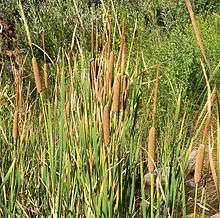Typha domingensis
| Typha domingensis | |
|---|---|
 | |
| Scientific classification | |
| Kingdom: | Plantae |
| (unranked): | Angiosperms |
| (unranked): | Monocots |
| (unranked): | Commelinids |
| Order: | Poales |
| Family: | Typhaceae |
| Genus: | Typha |
| Species: | T. domingensis |
| Binomial name | |
| Typha domingensis Pers. | |
| Synonyms[1] | |
|
Typha angustata Bory & Chaub. | |
Typha domingensis, known commonly as southern cattail[2] or cumbungi, is a perennial herbaceous plant of the genus Typha.
It is found throughout temperate and tropical regions worldwide. It is sometimes found as a subdominant associate in mangrove ecosystems such as the Petenes mangroves ecoregion of Yucatán.[3]
In Turkish folk medicine the female inflorescences of this plant and other Typha are used externally to treat wounds such as burns. Extracts of T. domingensis have been demonstrated to have wound healing properties in rat models.[4]
Water extracts of the fruit, female flower and male flower of Typha domingensis exhibit iron chelating activity as well as superoxide and nitric oxide scavenging activities. By contrast, only the fruit and female flower extracts were found to have alpha-glucosidase inhibitory activity.[5]
Recently it was found that Typha domingensis is very effective at reducing bacterial contamination of water for agricultural use. This plant helps to reduce, up to 98 percent, pollution by enterobacteria (usually found in the intestines of mammals) involved in the development of disease.[6]
Typha domingensis grows in Afghanistan, Albania, Algeria, the Andaman Islands., Angola, Argentina, Armenia, Assam, Australia, Azerbaijan, the Azores, the Balearic Islands, Bangladesh, Benin, Bermuda, Bolivia Ecuador, Bosnia & Herzegovina, Botswana, Brazil, Bulgaria, Burkina Faso, Burma, Canary Islands, Cape Verde, Central African Republic, Central America, Chad, China, Congo-Brazzaville, Congo-Kinshasa, Corsica, Ivory Coast, Crete, Crimea, Croatia, Cyprus, Djibouti, Egypt, Eritrea, Ethiopia, Fiji, France (incl. French Guinea & Réunion), Gabon, Gambia, Georgia, Ghana, Greece, Guinea-Bissau, Guyana, India, Indonesia, Iran, Iraq, Israel, Italy, Japan (incl. Ryukyu Islands), Kazakhstan, Kenya, Korea, Kosovo, Kyrgyzstan, Lebanon, Libya, Malawi, Malaysia, Mali, Malta, Mauritania, Mauritius, Mexico, Mongolia, Montenegro, Morocco, Mozambique, Nepal, New Caledonia, New Guinea, Niger, Nigeria, Norfolk Island, Oman, Pakistan, Palestine, Paraguay, Peru, Philippines, Portugal, Romania, Russia, Rwanda, Sardinia, Saudi Arabia, Senegal, Serbia, Seychelles, Slovenia, the Society Islands, Somalia, Spain, Sri Lanka, Sudan, Suriname, Switzerland, Syria, Tajikistan, Tanzania, Thailand, Toto, Tunisia, Turkey, Uganda, Ukraine, the United States (incl. Hawaii), the Uruguay, Uzbekistan, Venezuela, Vietnam, the West indies, Yemen, and Zambia[7]
References
- ↑ "Typha domingensis Pers.". World Checklist of Selected Plant Families (WCSP). Royal Botanic Gardens, Kew. Retrieved 5 January 2016 – via The Plant List.
- ↑ "Typha domingensis". Natural Resources Conservation Service PLANTS Database. USDA. Retrieved 12 December 2015.
- ↑ World Wildlife Fund. Eds. M. McGinley, C. M. Hogan, & C. Cleveland. 2010. Petenes mangroves. Encyclopedia of Earth. National Council for Science and the Environment. Washington, DC.
- ↑ Akkol, E. K., et al. (2011). The potential role of female flowers inflorescence of Typha domingensis Pers. in wound management. Journal of Ethnopharmacology 133(3) 1027-32.
- ↑ Chai TT, Mohan M, Ong HC, Wong FC (2014) Antioxidant, iron-chelating and anti-glucosidase activities of Typha domingensis Pers. (Typhaceae). Tropical Journal of Pharmaceutical Research 13(1): 67-72.
- ↑ Common weed revealed to diminish water pollution
- ↑ Kew World Checklist of Selected Plant Families, Typha domingensis
External links
| Wikimedia Commons has media related to Typha domingensis. |